Work on the lockups was not part of the multi-million dollar rehabilitation project at the Georgetown Magis-trate’s Court Complex, according to Registrar of the Supreme Court, Rashid Mohamed, who says that following Monday’s breakout work was done before the end of the day not only to seal the breach but to make it impenetrable.
Mohamed during a recent interview with Stabroek News said that the escape of four prisoners who managed to penetrate horizontal steel bars and a layer of diamond mesh before scaling a six-foot chain-link fence surmounted by barbed wire came as a shock to him. He said that while the security of prisoners is not the responsibility of the court administration, the issue will be given attention as the protection of the court staff is very important.
He said that the court administration footed the bill to repair and reinforce the damaged ventilation window and would soon be examining its budget with a view to sourcing money to replace the barbed wire at the top of the back fence with razor wire. Security sources had pointed out that razor wire was a better option owing to its circular design and width, and would be more difficult to negotiate since it could cause serious injury to anyone attempting to climb over it.
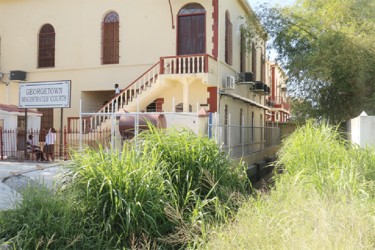
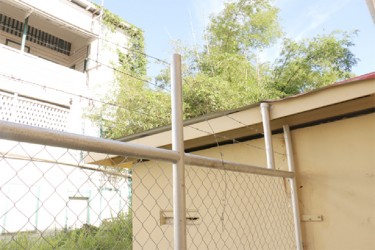
Last Monday murder accused Vickram Persaud, called ‘Lil John’, 28, of Doctor Dam, La Grange, West Bank Demerara, armed robbery accused Randolph Marks and Keron Cummings of Sophia and murder accused Steve Bacchus managed to escape. Bacchus only managed to make it to Hadfield Street before the police caught him.
Around 7.20 pm that day Persaud was fatally shot by police during what they described as “an armed confrontation.” Marks was found around 1.15 am on Tuesday hiding underneath a bed in a house at Freeman Street, East La Penitence, Georgetown. Cummings, an armed robbery accused, remains at large.
While it unclear how the three managed to escape from the area so quickly, people had observed Persaud entering a car, raising the possibility that the break-out was planned. He may have travelled to West Coast Berbice in the same vehicle.
Bacchus and Marks have since been sentenced to two years imprisonment each for escaping. They have both denied that the breakout was planned.
During his court appearance an emotional Bacchus told Chief Magistrate Priya Sewnarine-Beharry that he decided to escape after he heard that the magistrate presiding over the preliminary inquiry into the charge against him was not well on Monday. He also said that the attorney he hired to represent him never fulfilled the contractual agreement in spite of being paid $800,000.
“I was confused and frustrated,” Bacchus said, before explaining that when he was returned to the holding cell he noticed the window open with two shirts dangling from it. “I went to pray and read my Bible,” he related, saying it was half an hour later that he saw Persaud escape, followed by Marks. It was five minutes after that, he said, that he decided to set himself free. “Not like I plan or [work] with anyone,” he continued, and he asked the court to understand that his actions were a result of his frustration; “I accept that I was wrong.”
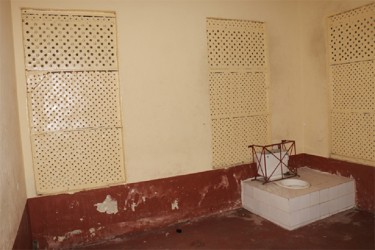
Marks claimed too that frustration drove his actions when the Chief Magistrate requested that he answer the charge. Marks told the court that he had made a run for it five minutes after he returned to the cell and saw Persaud and another prisoner escape.
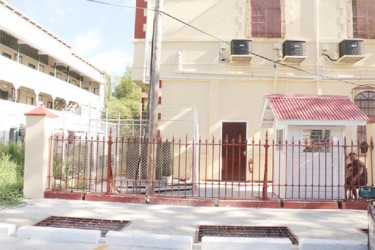
Persons at the court had said that the bars on the window had been weakened by prisoners constantly pulling on them thus making them easy to remove. On the basis of what this newspaper was told the escapees managed to remove two of the four horizontal bars. In the process of climbing through the small opening one of them sustained a cut as there was evidence of blood on the wall beneath the window.
Not identified
Mohamed explained that the $160M rehabilitation work was done under the Modernization of the Justice Adminis-tration System (MJAS) project which had two components, one involving the Attorney General’s Chamber and the other involving the Supreme Court.
He emphasised that work on the lockups, particularly the ventilation window which was secured with diamond mesh and iron bars, was not identified to be undertaken because it was considered to be in order.
Mohamed referred to sections of the press describing the work on the lockups as sloppy, but “it wasn’t identified to be done,” he explained, adding that despite this one of the two contracting services tasked with the repairs did some work in the cell from which the men escaped. Some work was also done on the police outpost.
He said that in relation to the lockups PD Contracting raised the concrete a little and with respect to the outpost they changed windows and did some tile work. Additionally he said that the contracting service executed some additional protection work in the ladies’ holding cell with regard to ensuring that items could not pass through the grillwork.
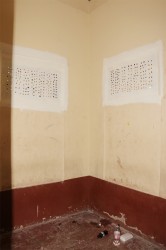
The registrar explained that initially the work comprised rehabilitating court rooms, constructing additional courts and work in the office. Subsequently, he said, there was additional work done to more court rooms.

He stressed that at no point did anyone raise an issue about the security of the ventilation window of the cell where the men were held. He said that although not part of the contract, minor work was done in the lockups to make it look tidy.
He informed this newspaper that PD Constructing did work on the upstairs floor – adding court rooms and rehabilitating existing ones. They also rehabilitated the offices. Another construction company – Alvin Chowramootoo Construction Service added courtrooms downstairs, he said.
Stabroek News visited PD Constructing at its Vreed en Hoop location but was unable to meet with the owner.
Mohamed also told Stabroek News that the court itself did some work on its own in relation to the sewerage system. He said that it was after court started that it was reported there was a sewage problem. “It wasn’t a contractor problem. It was a GWI problem,” he said, adding that GWI officials came and after assessing the situation made recommendations to effect some changes to the septic tanks. “We fixed that problem internally. GWI carried out the inspection and they even supervised, so it was they who detected certain flaws in the system. The system was troubled by [one] of the contractors,” he said. When told that there was still an unmistakable smell of sewage permeating the air when this newspaper visited the Magistrate’s court the day after the breakout, Mohamed responded that he was unaware that the issue had arisen again but would make a check.
With reference to the breakout, he said that when his staff became aware of it, the problem of the ventilation window was fixed almost immediately. He said that it was sealed with iron rods secured with metal bolts. As things stand now, steel plates are on the inside of all the ventilation windows in both the male and female lockups. Over this plate there are steel rods and diamond mesh. All of this is secured tightly with pieces of wood around the four sides. He said that it was reported in a section of the press that the repairs to the breached ventilation window had been undertaken by the police, but this was not the case; the work had been done by the Supreme Court.
He went on to comment that according to the accounts given by the police after the escape, they had received a report that something would happen in relation to a breakout either at the jail or the holding cell.
The point was made that it was not just the four but others as well who assisted in the bending of the steel rods to facilitate the escape.
Mohamed questioned whether noise would not have been made while the diamond mesh was being removed. He added that not only was the police office right outside the cell from which the men escaped, but also that ranks would be at the side.
He said that he was shocked when he heard of the breakout because “my first question was, weren’t the police there?” He said too that the breakout could not have happened so quickly.
“I am sure that the rods were out before. They must have seen evidence of broken concrete …” he observed.
While noting that prisoners will sometimes go to desperate lengths to be free, the police in the light of the breakout would have to be more vigilant. “No one ever thought about those things because we were depending on the police for security,” he said.
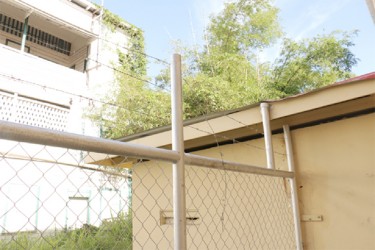
Asked about concerns relating to the quality of the fencing at the back of the complex, Mohamed admitted that it could be easily scaled. He said that the contractors installed barbed wire, but “we are looking at our budget to get razor wire at the top of the fence instead.”
One of the guard huts is located on the northern side of the building. Asked about its placement there, he responded that the guard is not responsible for prisoners but rather the security of the building.
“We have to put facilities there according to the specification and there have never been any complaints about that window,” he said, adding that it was believed that the double security – the metal bars and the diamond mesh – was enough.
Asked whether or not there are plans in the making to meet with the police to discuss a working relationship in providing better security at the courts, he said that a report was filed to the chancellor who is presently out of the country and he would have to make that decision.
He said that given what has happened it would appear as though we will have to start assisting the police for the sake of the staff.
With regard to the tall grass at the back of the building the registrat said that cutting the grass is the responsibility of the city council. For the sake of security of the staff, he said the court administration may have to consider paying to have it cut as is being done for garbage removal.
“We have staff there and we must protect them,” he said.
No sense
A security source told Stabroek News that it made no sense to bypass the lockups when it is a part of the complex being rehabilitated.
“What is the purpose of the lockups? Isn’t it connected with what goes on in the court? …You can’t divorce the lockups from the court,” the source commented, saying it made no sense to “look after one part and leave one part.”
According to the source “it doesn’t mek a whole lot of sense to me.” It was noted that if you are looking after a court complex, it has to be ensured that there are proper holding facilities there. “There is no excuse that can justify that the lockups were not looked after,” the source said, adding that had a careful inspection of the building been done or the police consulted, it may have been recognized that the security of the lockups ought to be strengthened.









